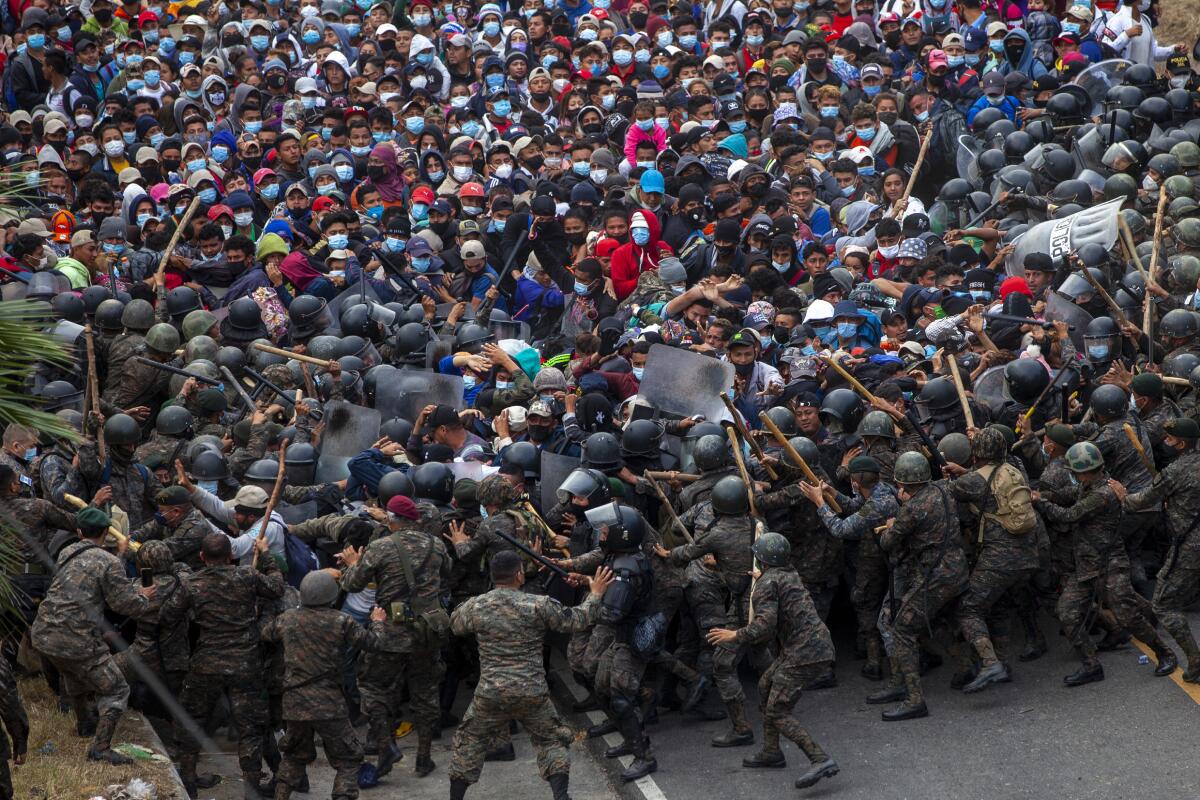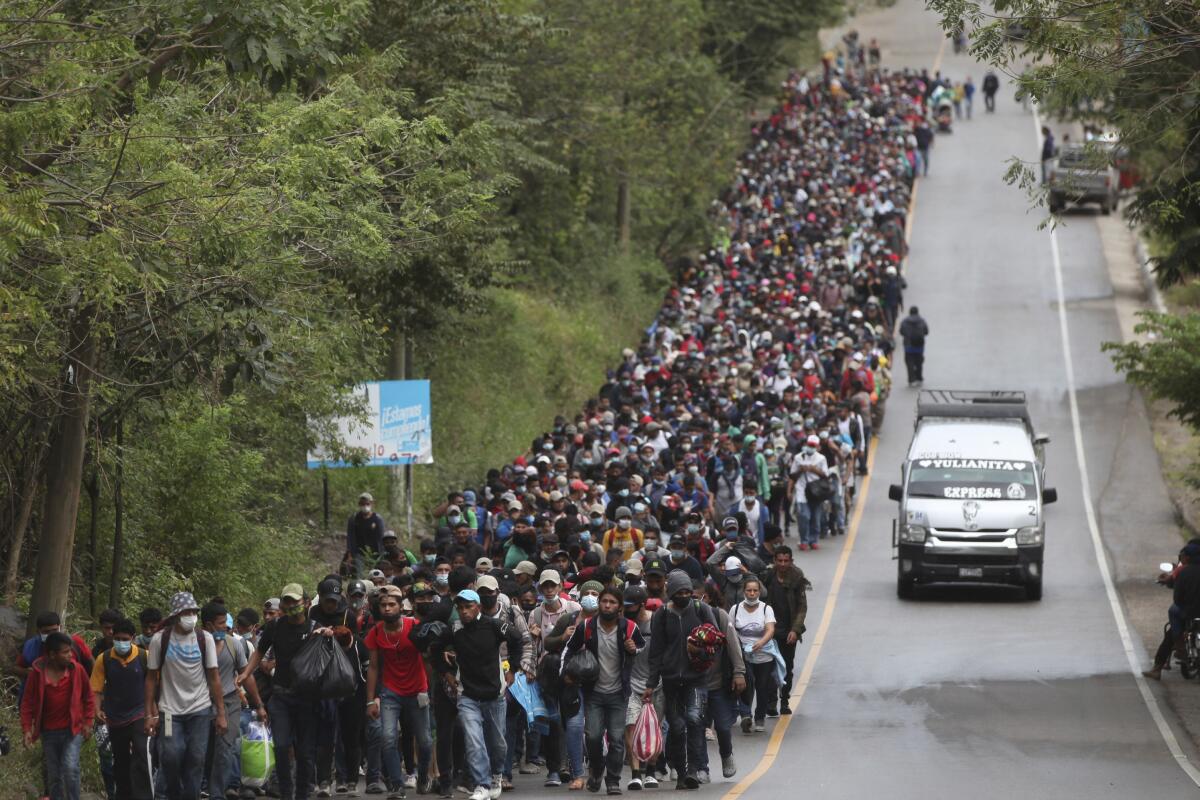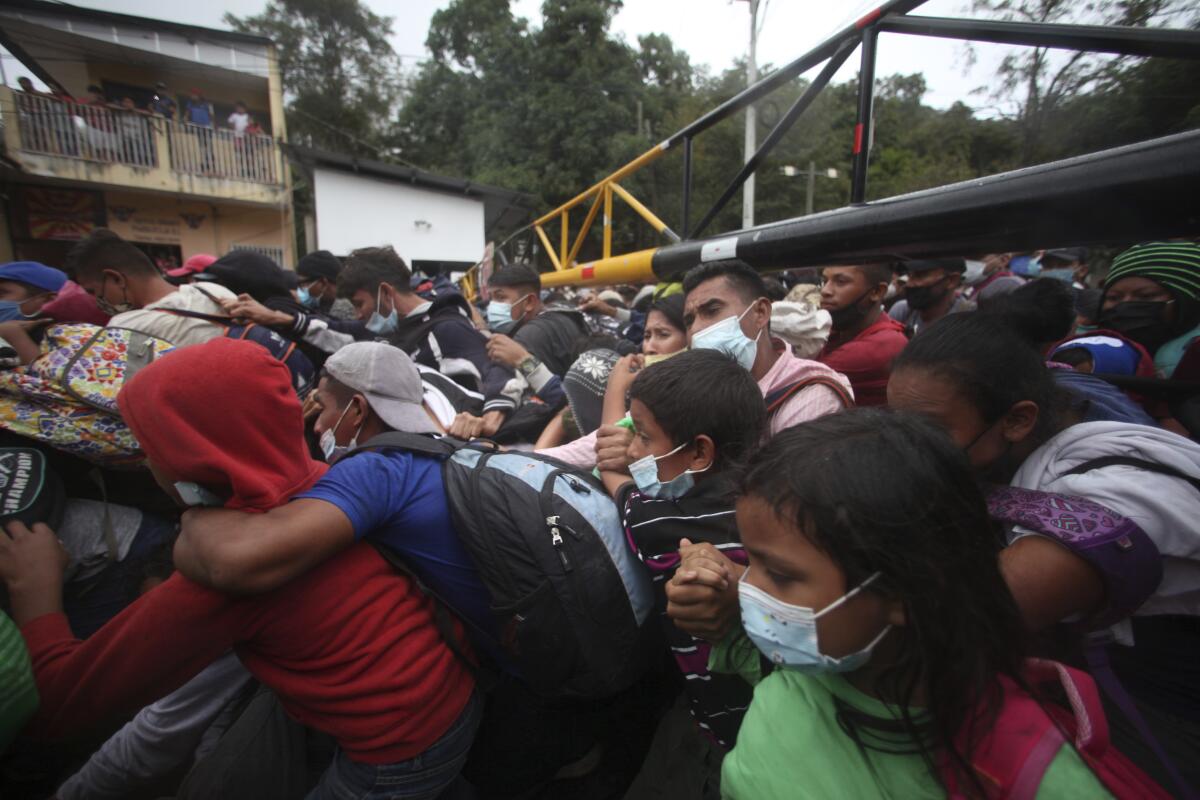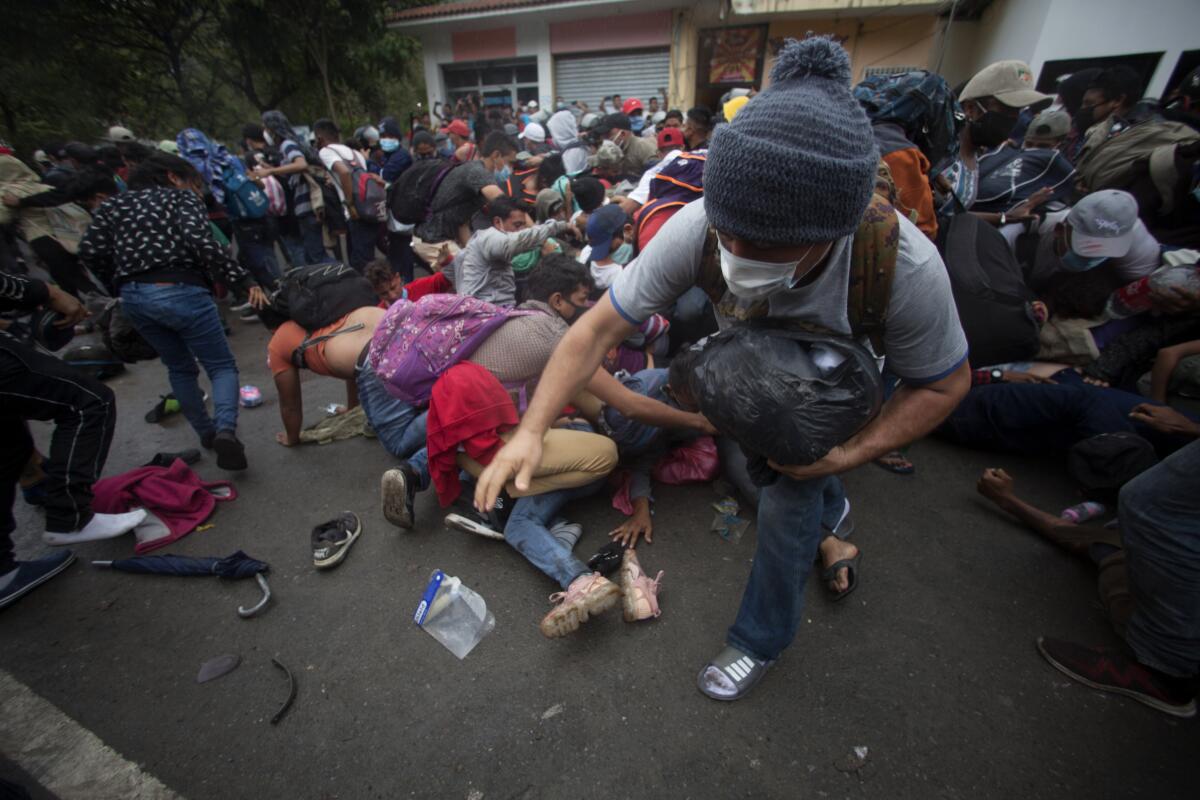For members of a migrant caravan, Biden’s immigration plan means little right now

- Share via
EL FLORIDO, Honduras — Roger was right back where he started.
He crossed into Guatemala this month with thousands of fellow Hondurans seeking to make it to the United States, only to become one of thousands sent back.
“We thought it was going to be different, but they treated us as badly as in Honduras — or even worse,” he said.

Roger, who spoke on condition that his last name not be used because of security concerns, had just descended from a bus at the El Florido border crossing Wednesday with about two dozen other Honduran men, women and children who had been rounded up by Guatemalan authorities.
They were greeted by money changers conducting business from a wooden bench next to a sign that said, “Welcome to Honduras.”
It was a familiar scene. For the last four years, the Trump administration successfully pressured governments in Central America and Mexico to stem the flow of migrants before they reached the U.S. border.

In his first days in office, President Biden has already abandoned many of his predecessor’s hard-line immigration policies, reversing travel bans from certain Muslim-majority countries, declaring a 100-day moratorium on most deportations, and reiterating his pledge to propose legislation providing a path to citizenship for an estimated 11 million people in the United States illegally.
But none of those policy changes do much for people fleeing Central America now until they make it to the U.S. border — and that trek has become increasingly difficult. The Biden administration has given no indication that it will instruct other countries to ease their crackdowns on U.S.-bound migrants.
Roughly 7,500 migrants, the vast majority of them Honduran, began making their way on foot to Mexico and the United States in large caravan groups a week ago. Most entered Guatemala through the El Florido crossing, but they made it only 27 miles into Guatemala before they were stopped.

Military and police forces blocked the group’s advance in the village of Vado Hondo.
On Jan. 18, hundreds of soldiers and police officers forcibly cleared the highway, pushing people back toward the border and essentially disbanding the caravan.
Roger scrambled through the hills and brush to bypass checkpoints, but his small group ran into security forces two days later about 25 miles north of Vado Hondo. He limped as he got off the bus in El Florido, using a stick as a cane.
As of Thursday evening, Guatemala had sent back at least 4,517 Hondurans, 111 Salvadorans and five Nicaraguans during the previous week.
Some migrants have been gathering along the Guatemalan border with Mexico, where hundreds of troops and immigration agents from both countries have been deployed to thwart them. Small groups made it across throughout the week.
Caravans became common during the Trump administration, which denounced them as an “invasion” and strong-armed Central American governments and Mexico into deploying police and troops to stop the flow.
This month’s exodus faced new challenges because of the pandemic.
Justifying its response on the basis of public health, the Guatemalan government enacted emergency measures in border regions and deployed more than 2,000 soldiers and police along with immigration and health personnel.
Honduran, Salvadoran and Nicaraguan adults once only needed their ID cards to enter Guatemala, but they now are also required to show negative coronavirus test results. Very few people can afford testing.
The factors driving people to flee have also shifted. Poverty and gang violence have been pushing migrants north for years. But the latest caravan was also full of people whose lives were upended by two Category 4 hurricanes that swept through Central America in November.
Roger was one of more than 500,000 Hondurans who had to evacuate. When hurricane rains caused rivers to flood, everyone in his San Pedro Sula neighborhood had to get out.
Most of his neighbors sought shelter in a school, but Roger, his wife and their two children, 9 and 11, crammed into his brother’s home. They have since been able to return home, but flooding destroyed all their belongings.
“We lost everything in the house,” Roger said.
He had hoped to make it to the United States and find work to send money home to his family, but beyond that had no concrete plans.
At least some Hondurans in the caravan had planned to seek asylum in the United States, while others hoped to be allowed to stay in Mexico on humanitarian grounds.
The Trump administration argued that most Central American migrants did not qualify for asylum because they were fleeing economic hardship, not persecution based on race, religion, political beliefs or other factors as the law requires.
To discourage applications, it instituted a policy known as “Remain in Mexico,” forcing tens of thousands of Central Americans to wait in Mexico while their claims were adjudicated — a process that can drag on for years.
The Biden administration has stopped sending new asylum seekers back to Mexico while it reviews the policy.
According to the World Bank, Honduras spends less than most other Latin American countries on health, education and other social services.
Many of the migrants lashed out at their government for corruption and not doing more to provide for citizens.
The 2017 reelection of Honduran President Juan Orlando Hernández, a close U.S. ally, was widely contested, sparking months of protests against election fraud and violent repression.
An Organization of the American States electoral observation mission stated it could not validate the results due to irregularities. But Washington recognized Hernández as the victor.
Less than two years later, a U.S. court convicted the president’s brother and former congressman Antonio Hernández on drug trafficking and weapons charges. The president is alleged to be an unindicted co-conspirator in the case.
U.S. prosecutors have also implicated Honduran police and military forces in drug trafficking and organized crime.
Biden has pledged to support anti-corruption efforts in northern Central American countries and his plans for the region include a $4-billion aid package. Whether his administration will take any steps against the Honduran president is not clear. But some question whether sending more cash to the region is the right strategy in a region where foreign aid seldom trickles down to the most needy.
“Pouring aid into corrupt, predatory governments and abusive security forces is not the answer,” said Lisa Haugaard, co-director of the Latin America Working Group, a human rights organization based in Washington, in a statement. “Nor is the answer just promoting private investment.”
Heidi Arely García, 19, has more immediate needs. She fled Honduras with the caravan hoping to make it somewhere to find work to shelter, feed and clothe her toddler.
García used to make four dollars a day helping a neighbor make snacks to sell, but she lost her job when her neighbor fell ill. Then the hurricanes flooded her community in Colinas, 60 miles southwest of San Pedro Sula.
“The water wrought havoc there,” she said in Vado Hondo, before the Guatemalan military and police broke up her caravan.
“I am ready for whatever God decides,” García said, “whether I get through or not.”
Cuffe is a Times special correspondent.
More to Read
Sign up for Essential California
The most important California stories and recommendations in your inbox every morning.
You may occasionally receive promotional content from the Los Angeles Times.










